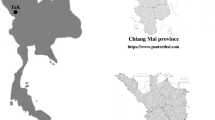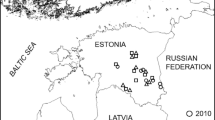Abstract
Prior to 1996, the A2 mating type of Phytophthora infestans was not detected on potato in France, but was found at one site on tomato in 1995. This finding lead to the question of the extent of differences and relationships existing between the populations of P. infestans present on each host. A collection of 76 isolates collected in France, mainly in 1996, from potato and tomato was characterised for mating type, allozyme genotype at the Gpi and Pep loci, and mitochondrial DNA haplotype; 74 of these isolates were also characterised for multilocus RFLP fingerprint, and 62 for virulence. All isolates except four showed allozyme genotypes (Gpi 90/100 or 100/100, Pep 83/100 or 100/100) and mtDNA haplotypes (Ia or IIa) characteristic of the populations introduced into Europe in the late 1970s. The four exceptions were isolates collected from tomato in Southern France in 1988-1991, which showed some characteristics of the former European populations (Gpi 86/100, Pep 92/100, mtDNA Ib). Both mating types were present among the collections from both hosts, but isolates with the A2 mating type were found on potato only in one garden crop, adjacent to tomato. Nine different RG57 fingerprints were observed, with a greater diversity among tomato isolates. Furthermore, tomato and potato collections differed markedly in the frequencies of genotypes present. Finally, tomato isolates generally had a lower virulence complexity than potato isolates. These data suggest that P. infestans populations on tomato and potato are largely separated, despite the occurrence of limited gene flow.
Similar content being viewed by others
References
Andrivon D (1994a) Races of Phytophthora infestansin France, 1991-1993. Potato Res 37: 261-268
Andrivon D (1994b) Race structure and dynamics in populations of Phytophthora infestans. Can J Bot 72: 1681-1687
Andrivon D (1996) The origin of Phytophthora infestanspopulations present in Europe in the 1840s: a critical review of historical and scientific evidence. Plant Pathol 45: 1027-1035
Andrivon D, Béasse C, and Laurent C (1994). Characterization of isolates of Phytophthora infestanscollected in Northern France from 1988 to 1992. Plant Pathol 43: 471-478
Carter DA, Archer SA, Buck KW, Shaw DS and Shattock RC (1991) DNA polymorphisms in Phytophthora infestans: the UK experience. In: J. A. Lucas, R. C. Shattock, D. S. Shaw and L. R. Cooke, (eds) Phytophthora. (pp 272-294) Cambridge University Press, Cambridge, UK
Daggett SS, Götz E and Therrien CD (1993). Phenotypic changes in populations of Phytophthora infestansfrom eastern Germany. Phytopathology 83: 319-323
Day JP and Shattock RC (1997) Aggressiveness and other factors relating to displacement of populations of Phytophthora infestansin England and Wales. Eur J Plant Pathol 103: 379-391
Drenth A, Tas ICQ and Govers F (1994) DNA fingerprinting uncovers a new sexually reproducing population of Phytophthora infestansin the Netherlands. Eur J Plant Pathol 100: 97-107
Drenth A, Goodwin SB, Fry WE and Davidse LC (1993a). Genotypic diversity of Phytophthora infestansin the Netherlands revealed by DNA polymorphisms. Phytopathology 83: 1087- 1092
Drenth A, Turkensteen LJ and Govers F (1993b) The occurrence of the A2mating type of Phytophthora infestansin the Netherlands; significance and consequences. Neth J Plant Pathol 99, suppl. 3: 57-67
Forbes GA, Escobar XC, Ayala CC, Revel J, Ordoñez ME, Fry BA, Doucett K and Fry WE (1997) Population genetic structure of Phytophthora infestansin Ecuador. Phytopathology 87: 375-380
Fry WE, Drenth A, Spielman LJ, Mantel BC, Davidse LC and Goodwin SB (1991) Population genetic structure of Phytophthora infestansin the Netherlands. Phytopathology 81: 1330- 1336
Fry WE, Goodwin SB, Dyer AT, Matuszak JM, Drenth A, Tooley PW, Sujkowski LS, Koh YJ, Cohen BA, Spielman LJ, Deahl KL, Inglis DA and Sandlan KP (1993). Historical and recent migrations of Phytophthora infestans: chronology, pathways, and implications. Plant Dis 77: 653-661
Fry WE, Goodwin SB, Matuszak JM, Spielman LJ, Milgroom MG and Drenth A (1992) Population genetics and intercontinental migrations of Phytophthora infestans. Annu Rev Phytopathol 30: 107-129
Goodwin SB, Cohen BA and Fry WE (1994) Panglobal distribution of a single clonal lineage of the Irish potato famine fungus. Proc Nat Acad Sci USA 91: 11591-11595
Goodwin SB, Drenth A and Fry WE (1992) Cloning and genetical analysis of two highly polymorphic, moderately repetitive nuclear DNAs from Phytophthora infestans. Curr Genet 22: 107-115
Goodwin SB, Sujkowski LS, Dyer AT, Fry BA and Fry WE (1995) Direct detection of gene flow and probable sexual reproduction of Phytophthora infestansin Northern North America. Phytopathology 85: 473-479
Groth JV and Roelfs AP (1987) The concept and measurement of phenotypic diversity in Puccinia graminison wheat. Phytopathology 77: 1395-1399
Jaccard P (1908) Nouvelles recherches sur la distribution florale. Bull Soc Vaudoise Sci Nat 44: 223-270
Kato M and Fry WE (1995) Competitive fitness of a new and old lineage of Phytophthora infestansin the USA. Phytopathology 85: 1557 (abstract)
Kato M, Mizubuti ES, Goodwin SB and Fry WE (1995). Sensitivity to protectant fungicides and pathogenic fitness of clonal lineages of Phytophthora infestansin the United States. Phytopathology 87: 973-978
Koh YJ, Goodwin SB, Dyer AT, Cohen BA, Ogoshi A, Sato N and Fry WE (1994) Migrations and displacements of Phytophthora infestanspopulations in east Asian countries. Phytopathology 84: 922-927
Lebreton L and Andrivon D (1995) Structure of Phytophthora infestanspopulations in France 1992-1994. In: L. J. Dowley, E. Bannon, L. R. Cooke, T. Keane and E. O'Sullivan, (eds) Phytophthora infestans 150. (pp 368-369) Boole Press Ltd, Dublin (abstract)
Lebreton L, Duvauchelle S and Andrivon D (1996). Occurrence in France and Belgium of A2 mating type isolates of Phytophthora infestansin 1995. (pp 262-263) In: Abstracts of Conference Papers, Posters and demonstrations, 13thTriennal Conf. Europ. Assoc. Potato Res, Veldhoven, The Netherlands
Lebreton L, Laurent C and Andrivon D (1998) Evolution of Phytophthora infestanspopulations in the two most important potato production areas of France during 1992-1996. Plant Pathology 47 (in press)
Legard DE, Lee TY and Fry WE (1995) Pathogenic specialization in Phytophthora infestans:aggressiveness on tomato. Phytopathology 85: 1356-1361
Micales, JA, Bonde, MR and Peterson GC (1986) The use of allozyme analysis in fungal taxonomy and genetics. Mycotaxon 27: 405-449
Mosa AA, Kobayashi K and Ogoshi A (1993) Isoenzyme polymorphism and segregation in isolates of Phytophthora infestansfrom Japan. Plant Pathol 42: 26-34
Oyarzun PJ, Pozo A, Ordoñez ME, Doucett K and Forbes GA (1998) Host specificity of Phytophthora infestanson tomato and potato in Ecuador. Phytopathology 88: 265-271
Pipe ND and Shaw DS (1997) Telomere-associated restriction fragment length polymorphisms in Phytophthora infestans. Molec. Plant Pathol. On Line http: //www. bspp. org. uk/mppol/1997/1124pipe
Sato N and Kato M (1993) Improvement of the selective medium and method for the isolation of Phytophthora infestans. Ann Phytopathol Soc Japan 59: 568-571
Shaw CR and Prasad M (1970) Starch gel electrophoresis of allozymes: a compilation of recipes. Biochem Genet 4: 297-320
Spielman LJ, Drenth A, Davidse LC, Sujkowski LJ, Gu W, Tooley PW and Fry WE (1991) A second world-wide migration and population displacement of Phytophthora infestans? Plant Pathol 40: 422-430
Spielman LJ, Mc Master BJ and Fry WE (1989) Dominance and recessiveness at loci for virulence against potato and tomato in Phytophthora infestans Theor Appl Genet 77: 832-838
Spielman LJ, Sweigard JA, Shattock RC and Fry WE (1990) The genetics of Phytophthora infestans: segregation of allozyme markers in F2 and backcross progeny and of virulence against potato resistance genes R2 and R4 in F1 progeny. Exp Mycol 14: 57-69
Sneath PHA and Sokal RR (1973) Numerical Taxonomy. W. H. Freeman and Co., San Francisco
Sujkowski LS, Goodwin SB, Dyer AT and Fry WE (1994). Increased genotypic diversity via migration and possible occurrence of sexual reproduction of Phytophthora infestansin Poland. Phytopathology 84: 201-207
Tooley PW, Therrien CD and Rich DL (1989) Mating type, race composition, nuclear DNA content, and allozyme analysis of Peruvian isolates of Phytophthora infestans. Phytopathology 79: 478-481
Author information
Authors and Affiliations
Rights and permissions
About this article
Cite this article
Lebreton, L., Andrivon, D. French isolates of Phytophthora infestans from potato and tomato differ in phenotype and genotype. European Journal of Plant Pathology 104, 583–594 (1998). https://doi.org/10.1023/A:1008662518345
Issue Date:
DOI: https://doi.org/10.1023/A:1008662518345




